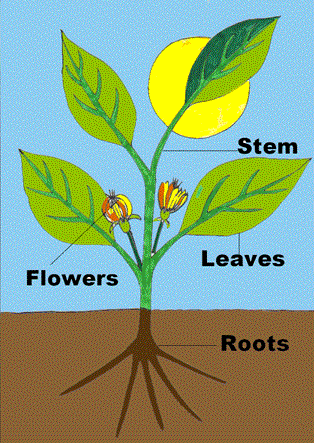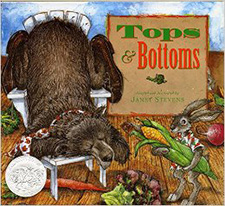Plant Tops and Bottoms
Students identify where fruits and vegetables belong on the MyPlate diagram and describe the major parts of plants—roots, stems, leaves, flowers, and fruits—according to if they are produced on the top or bottom of a plant.
Background
Lesson Activities
Recommended Companion Resources
Credits
Author
Minnesota Agriculture in the Classroom
Acknowledgements
- This lesson was adapted from Oklahoma Agriculture in the Classroom's lesson Plant Parts we Eat.
- The plant parts image is from http://www.zephyrus.co.uk/plantquiz1.html
- Ag facts were taken from www.myplate.gov
Standards
Texas Content Area Standards
-
ELA: K.110.2.b.1
Developing and sustaining foundational language skills: listening, speaking, discussion, and thinking - - oral language. The student develops oral language through listening, speaking, and discussion.
- ELA: K.110.2.b.1.C: share information and ideas by speaking audibly and clearly using the conventions of language
- ELA: K.110.2.b.1.D: work collaboratively with others by following agreed-upon rules for discussion, including taking turns;
-
ELA: K.110.2.b.6
Response skills: listening, speaking, reading, writing, and thinking using multiple texts. The student responds to an increasingly challenging variety of sources that are read, heard, or viewed.
- ELA: K.110.2.b.6.F: respond using newly acquired vocabulary as appropriate
-
ELA: 1.110.3.b.1
Developing and sustaining foundational language skills: listening, speaking, discussion, and thinking - - oral language. The student develops oral language through listening, speaking, and discussion.
- ELA: 1.110.3.b.1.C: share information and ideas about the topic under discussion, speaking clearly at an appropriate pace and using the conventions of language
-
ELA: 1.110.3.b.7
Response skills: listening, speaking, reading, writing, and thinking using multiple texts. The student responds to an increasingly challenging variety of sources that are read, heard, or viewed.
- ELA: 1.110.3.b.7.F: respond using newly acquired vocabulary as appropriate
-
ELA: 2.110.4.b.1
Developing and sustaining foundational language skills: listening, speaking, discussion, and thinking -- oral language. The student develops oral language through listening, speaking, and discussion.
- ELA: 2.110.4.b.1.C: share information and ideas that focus on the topic under discussion, speaking clearly at an appropriate pace and using the conventions of language
- ELA: 2.110.4.b.1.D: work collaboratively with others by following agreed-upon rules for discussion, including listening to others, speaking when recognized, making appropriate contributions, and building on the ideas of others
-
ELA: 2.110.4.b.7
Response skills: listening, speaking, reading, writing, and thinking using multiple texts. The student responds to an increasingly challenging variety of sources that are read, heard, or viewed.
- ELA: 2.110.4.b.7.F: respond using newly acquired vocabulary as appropriate
-
Social Studies: K.113.11.c.5
Economics. The student understands the difference between human needs and wants and how they are met. The student is expected to:
- Social Studies: K.113.11.c.5.A: identify basic human needs of food, clothing, and shelter
- Social Studies: K.113.11.c.5.C: explain how basic human needs and wants can be met
-
Social Studies: 2.113.13.c.16
Social studies skills. The student communicates in written, oral, and visual forms. The student is expected to:
- Social Studies: 2.113.13.c.16.E: communicate information visually, orally, or in writing based on knowledge and experiences in social studies
-
Social Studies: K.113.11.c.13
Social studies skills. The student applies critical-thinking skills to organize and use information acquired from a variety of valid sources, including technology. The student is expected to:
- Social Studies: K.113.11.c.13.D: sequence and categorize information
-
Social Studies: K.113.11.c.14
Social studies skills. The student communicates in oral and visual forms. The student is expected to:
- Social Studies: K.113.11.c.14.C: communicate information visually, orally, or in writing based on knowledge and experiences in social studies
-
Social Studies: 1.113.12.c.16
Social studies skills. The student applies critical-thinking skills to organize and use information acquired from a variety of valid sources, including technology. The student is expected to:
- Social Studies: 1.113.12.c.16.D: sequence and categorize information
-
Social Studies: 1.113.12.c.17
Social studies skills. The student communicates in oral, visual, and written forms. The student is expected to:
- Social Studies: 1.113.12.c.17.C: communicate information visually, orally, or in writing based on knowledge and experiences in social studies
-
Social Studies: 2.113.13.c.15
Social studies skills. The student applies critical-thinking skills to organize and use information acquired from a variety of valid sources, including technology. The student is expected to:
- Social Studies: 2.113.13.c.15.D: interpret oral, visual, and print material by sequencing, categorizing, identifying the main idea, predicting, comparing, and contrasting
-
Science: 2.112.4.b.1
Scientific and engineering practices. The student asks questions, identifies problems, and plans and safely conducts classroom, laboratory, and field investigations to answer questions, explain phenomena, or design solutions using appropriate tools and models. The student is expected to:
- Science: 2.112.4.b.1.F: record and organize data using pictures, numbers, words, symbols, and simple graphs
-
Science: K.112.2.b.1
Scientific and engineering practices. The student asks questions, identifies problems, and plans and safely conducts classroom, laboratory, and field investigations to answer questions, explain phenomena, or design solutions using appropriate tools and models. The student is expected to:
- Science: K.112.2.b.1.F: record and organize data using pictures, numbers, words, symbols, and simple graphs.
-
Science: K.112.2.b.5
Recurring themes and concepts. The student uses recurring themes and concepts to make connections across disciplines. The student is expected to:
- Science: K.112.2.b.5.A: identify and use patterns to describe phenomena or design solutions.
- Science: K.112.2.b.5.F: describe the relationship between the structure and function of objects, organisms, and systems.
-
Science: K.112.2.b.12
Organisms and environments. The student knows that plants and animals depend on the environment to meet their basic needs for survival. The student is expected to:
- Science: K.112.2.b.12.A: observe and identify the dependence of plants on air, sunlight, water, nutrients in the soil, and space to grow.
-
Science: K.112.2.b.13
Organisms and environments. The student knows that organisms resemble their parents and have structures and undergo processes that help them interact and survive within their environments. The student is expected to:
- Science: K.112.2.b.13.A: identify the structures of plants, including roots, stems, leaves, flowers, and fruits.
-
Science: 1.112.3.b.1
Scientific and engineering practices. The student asks questions, identifies problems, and plans and safely conducts classroom, laboratory, and field investigations to answer questions, explain phenomena, or design solutions using appropriate tools and models. The student is expected to:
- Science: 1.112.3.b.1.F: record and organize data using pictures, numbers, words, symbols, and simple graphs.
-
Science: 1.112.3.b.5
Recurring themes and concepts. The student uses recurring themes and concepts to make connections across disciplines. The student is expected to:
- Science: 1.112.3.b.5.A: identify and use patterns to describe phenomena or design solutions.
- Science: 1.112.3.b.5.F: describe the relationship between the structure and function of objects, organisms, and systems.
-
Science: 1.112.3.b.11
Earth and space. The student knows that earth materials and products made from these materials are important to everyday life. The student is expected to:
- Science: 1.112.3.b.11.A: identify and describe how plants, animals, and humans use rocks, soil, and water.
-
Science: 1.112.3.b.13
Organisms and environments. The student knows that organisms resemble their parents and have structures and undergo processes that help them interact and survive within their environments. The student is expected to:
- Science: 1.112.3.b.13.A: identify the external structures of different animals and compare how those structures help different animals live, move, and meet basic needs for survival.
-
Science: 2.112.4.b.5
Recurring themes and concepts. The student uses recurring themes and concepts to make connections across disciplines. The student is expected to:
- Science: 2.112.4.b.5.A: identify and use patterns to describe phenomena or design solutions
- Science: 2.112.4.b.5.F: describe the relationship between the structure and function of objects, organisms, and systems
-
Science: 2.112.4.b.13
Organisms and environments. The student knows that organisms have structures and undergo processes that help them interact and survive within their environments. The student is expected to:
- Science: 2.112.4.b.13.A: identify the roots, stems, leaves, flowers, fruits, and seeds of plants and compare how those structures help different plants meet their basic needs for survival
 Inform students that vegetables and fruits are plants. Draw or show a picture of the common parts of a plant
Inform students that vegetables and fruits are plants. Draw or show a picture of the common parts of a plant
 Show students the book Tops and Bottoms by Janet Stevens. Tell students that this book is about a rabbit and a bear who decided to grow some plants to eat. The title is Tops and Bottoms. Ask the students:
Show students the book Tops and Bottoms by Janet Stevens. Tell students that this book is about a rabbit and a bear who decided to grow some plants to eat. The title is Tops and Bottoms. Ask the students: